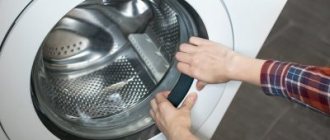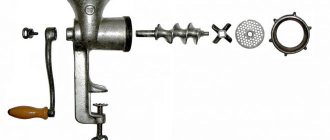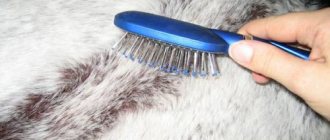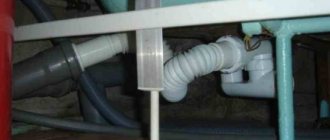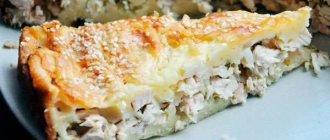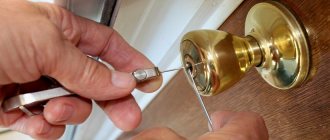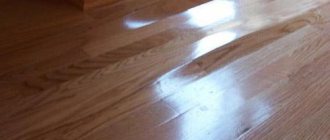Causes of jamming
There can be many reasons for the locking mechanism to jam; among the most common are:
- foreign objects getting into the keyhole;
- contamination of the castle with dust and small debris;
- attempts to unlock the door in the wrong way;
- inflating the wood web;
- skew;
- defects made during the production process;
- sting blocking;
- use of a duplicate key made with defects.
Attempts to open it through manipulation
If outside manipulations are performed on the door that are not provided for by the manufacturer, the lock may jam or break. Try to handle door leaves carefully, without subjecting them to unusual loads. This will extend their service life, and you will not have to waste time opening locks.
Foreign objects entering the well
Foreign objects getting into the keyhole most often occurs due to children's pranks. They do not realize that the lock is a fragile mechanism that can be easily damaged.
To avoid such a situation, explain to teenagers the possible consequences and refrain from unwanted experiments yourself.
Well contamination with dust or mechanical shavings
The lock cylinder is such a fragile thing that it is not necessary to insert foreign objects into it for problems to occur. It is enough to clog the keyhole with dust, and the lock will jam. If you handle keys made of low-quality metal carelessly, microscopic shavings will get into the mechanism, which also interferes with the normal functioning of the door.
See also
Ideas for crafts made of cement for a summer residence and how to properly make figures with your own hands
Inflating a wooden door leaf
If there is high humidity in the room and the door is made of wood, the mechanism may malfunction due to deformation of the material. To avoid this, try to ventilate the room and prevent liquid from getting on the wooden surface.
Use of the unlocking device for purposes other than its intended purpose
Keys are often used not only for opening locks, but also for outside manipulation, as auxiliary tools. This disrupts their shape, which negatively affects interaction with the locking mechanism.
Chips and scratches remain on the surface of the metal, where dirt collects. When it comes into contact with the keyhole, it remains inside, which speeds up the process of clogging it.
Strong slamming of a metal or wooden door
When problems arise when opening doors, many do not try to find and eliminate the cause of their occurrence. Instead, they start slamming the door, using excessive force. This approach negatively affects the integrity of the object and internal mechanisms, accelerating their destruction.
Warp door leaf
Unfortunately, not all manufacturers approach their business with due responsibility and attention. Some hastily designed door structures cannot support their own weight and become deformed after installation.
This causes the locking mechanism to jam, preventing the rightful owners from getting inside the apartment.
Note! Massive doors made of metal or dense wood should have more than 2 hinges.
Using a low quality duplicate key
When using duplicate keys made from low-quality materials, it is possible:
- clogging of the keyhole with metal shavings;
- the key, when opening, may break, getting stuck inside the cylinder;
- Damage to the inside of the mechanism due to the key not fully matching the original.
The pin falls out of the mechanism and the tip gets blocked
Pins are pins in the lock mechanism that ensure its reliability and security. The pins themselves are quite fragile and, if you do not follow the operating rules of the mechanism, they will begin to collapse faster. This will lead to jamming or breakage of the lock, which will complicate entry into the room.
Manufacturing defects
There are cases when a person is simply unlucky and buys a defective product. No matter how well you treat it, damage cannot be avoided. There is no way to influence this situation, and you can only rely on luck. The only thing that can reduce the risks is checking the product before purchasing.
Extreme measures
If the lock installed in the iron door of a private house is jammed and it cannot be opened in any way, then you will have to remove the door leaf from the hinges. If the door block is made of metal, this will be much more difficult to do. Such designs have increased protection against burglary.
You will need a grinder; it is used to cut the crossbar hinges. Then, after removing the canvas, the broken locking mechanism is removed, new hinges are mounted and a new lock is installed.
Another option is to saw the tongue of the locking mechanism. But this method can only be used if there is sufficient clearance between the door frame and the leaf to complete this procedure.
If there is play in the door metal block, you can use a regular crowbar to open it. This tool is inserted into a suitable gap between the door leaf and the floor base so that the door can be lifted.
If none of the listed methods helped to open a jammed metal front door, and there is no desire to spoil the integrity of the door structure, then it is recommended to contact specialists.
What to do
Once the main causes of breakdowns have been identified, it’s time to move on to ways to eliminate them. Each breakdown has individual recommendations for repair, but there are a number of general tips that are suitable for almost any similar situation.
See also
How to paint suede shoes at home, the best remedies and folk recipes
General recommendations
Experienced citizens who have repeatedly encountered similar problems recommend the following actions:
- If the mechanism jams while turning, clean or replace the cylinder. This will cost less than completely replacing the lock and will require less time for manipulation.
- If the key is stuck in the entrance lock and does not want to come out, treat the cylinder with lubricant. Kerosene or machine oil is suitable for these purposes.
- At the first sign of an impending breakdown, do not be lazy to disassemble the mechanism and check its condition.
Cylinder lock failure
The following problems may occur in the operation of the cylinder lock:
- Due to contamination, the mechanism will begin to turn worse, requiring more effort from the owner.
- The key gets stuck in the keyhole and it is impossible to pull it back out.
- During interaction with the mechanism, extraneous sounds appear.
It is difficult to fix problems that arise on your own due to the complexity of the mechanism. It is recommended to seek help from specialists.
Level type
If complications arise during insertion of the key into the mechanism cylinder, it is recommended:
- Insert the key on the back of the door.
- Grind off longitudinal protrusions that interfere with comfortable penetration. In situations where you cannot grind off the tabs, try applying light pressure on the keyhole.
How to remove a stuck or broken key
If your key is stuck in the lock and causing it to not turn, try one of the following methods:
- Treat the keyhole with oil or special lubricant.
- If the door is not closed, disassemble the lock and carefully remove the key.
- Using pliers or tweezers will help you remove the broken key.
Force methods
In cases where careful methods of influence do not help, they move on to forceful techniques. They are more effective, but can cause irreparable damage to the door or locking device. Forceful methods include:
- breaking out;
- knocking out;
- drilling;
- call the Ministry of Emergency Situations.
Breaking out
If the need arises to quickly open a stuck door, breaking it out will help. Algorithm of actions:
- take the gas key;
- use it to clamp the secret;
- we turn sharply.
The cylinder and the fasteners holding it are destroyed, thereby allowing the door to be opened.
Advantages of the method:
- speed;
- simplicity;
- the door remains intact.
Minuses:
- After such an impact, the lock will finally break. It cannot be restored.
Drilling
To drill, you need to insert a drill of a suitable size into the keyhole, and then drill out the pin mount. It holds the bolt and prevents the lock from turning. If everything is done correctly, the lock should turn smoothly inside the lock.
Note! It is necessary to drill out the secret to at least the middle, otherwise you will not achieve the desired result.
Knockout
When knocked out, the lock is completely destroyed, and it will not be possible to restore it, as is the case with drilling. To knock out the lock, you will need:
- prepare a hammer and chisel;
- place the chisel on the lock;
- knock out the lock cylinder with strong blows to the chisel.
See also
Step-by-step instructions on how to replace the door lock cylinder with your own hands
Try to use a heavier hammer, otherwise you will have to fiddle with the jammed mechanism for a long time.
Contacting the Ministry of Emergency Situations or specialists
Opening doors yourself is not always a good solution. The owner of the apartment may incorrectly determine the essence of the problem and cause more damage to his property than necessary. To prevent this from happening, contact the Ministry of Emergency Situations or companies specializing in hacking. They will minimize damage and get the job done much faster.
How to open the lock mechanism yourself
You can open an iron door lock yourself if you know what type is used. If we classify the object as cylinder, then we can use the methods of burglars:
- Find a similar key
- Open with a pick, after smoothing the pins.
- Use a screwdriver to remove the fittings.
- Get rid of internal, protective elements with acid.
Don't miss: How to open Cyfral intercom models 20 and 2094 without a key
Why won't the key turn in the door lock?
If the key is working properly and does not have any defects, there may be several reasons why it stopped opening the locks on the door:
- The spring under the security mechanism pin has broken. As a result, the pins tightly fix the teeth of the key and do not allow it to be removed from the hole.
- The internal parts of the larva are worn out. Wear causes the pins to fail to fit into the channels, causing the key to become locked in the door.
- The bolt is blocked. You can try to lift or press the door leaf to make it easier for the bolt to move in the striker. The main thing is not to apply excessive force to the key, otherwise it may break right in the keyhole.
Important! The reasons why the key is blocked in different types of locks can vary greatly. To understand this issue, it is advisable to have a good knowledge of the design of cylinder, lever and other types of locking devices. If the electronic lock is blocked, then you definitely can’t handle it without the help of a specialist.
